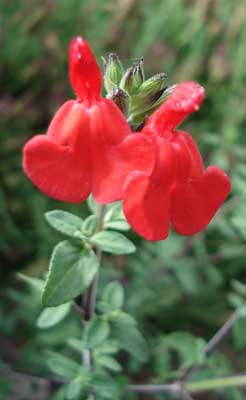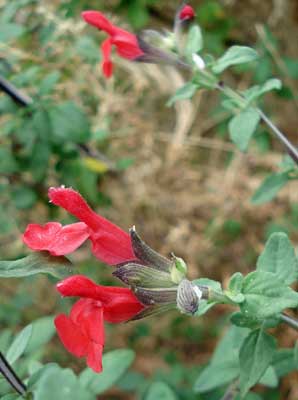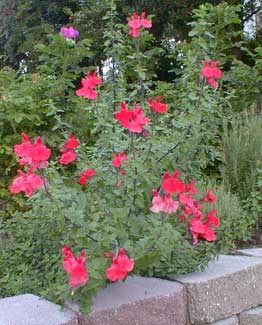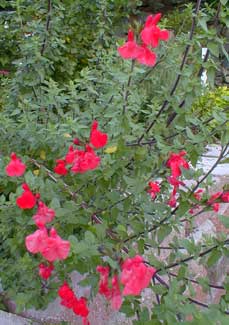
Cherry Sage; aka,
'Maraschino' Bush Sage
"I would I were a stone, or tree,
Or flower by pedigree,
Or some poor high-way herb, or Spring
To flow, or bird to sing!"
-Henry Vaughan
(1621-1695)
(1621-1695)
 'Maraschino' Cherry Bush-sage is a hybrid carefully developed by Rich Dufresne by crossing S. microphylla (aka S. grahamii) with S. greggii.
'Maraschino' Cherry Bush-sage is a hybrid carefully developed by Rich Dufresne by crossing S. microphylla (aka S. grahamii) with S. greggii.It has the tiny leaves of S. microphylla or Little-Leaf Sage from Mexico, & the bright-bright cherry-red flowers of S. greggii or Gregg's Cherry Sage. These two species hybridize so easily that if you have both species growing in your yard, any self-seeding will be of hybrids.
At its height of flower 'Maraschino' is covered all over with the bright red blooms such as are so liked by hummingbirds & butterflies. It flowers most extravagnatly for a long period from June to the entirety of September.
But really it attempts to bloom almost year round & will succeed if temperatures rarely fall into the twenties. But here on Puget Sound, in late winter on the cusp of spring, it stop blooming altogether, though only briefly, to prepare itself to grow new limbs & leaves for early spring.
It has a strong upright slender woody structure reaching about thirty inches high, slowly spreading into an airy two or three foot wide woody-stemmed shrublet.
 If sun hits it predominantly from one direction, it will become partially fountaining in the direction of the sun. If larger plants are behind it, it should not be planted so near the front border that it can't be kept from leaning over a path or sidewalk.
If sun hits it predominantly from one direction, it will become partially fountaining in the direction of the sun. If larger plants are behind it, it should not be planted so near the front border that it can't be kept from leaning over a path or sidewalk.If the production of a periodic bloom or two at any time out of season is discounted, then in our zone it stops blooming in late November to mid-December & starts up again by May, continuing to bloom more lightly throughout the Summer, then densely flowers again in late summer to mid Autumn, with sporadic bloom here & there through winter, even if it snows.
 Mild frosts slow it down a little, but the temperatures have to fall into the twenties before it cares a whole lot. A sustained cold snap can, however, kill it, so it may need trimming back & mulching if a harsh winter is expected.
Mild frosts slow it down a little, but the temperatures have to fall into the twenties before it cares a whole lot. A sustained cold snap can, however, kill it, so it may need trimming back & mulching if a harsh winter is expected.It will stop blooming entirely if surrounding shrubs begin to shade it. Ours was originally planted among small shrubs but the other shrubs got so big it was getting crowded, & bloomed very poorly its third year. So it was hard-pruned, dug up, & moved to a well-draining stone ledge where it gets the fullest morning sun & moderate sun the rest of the day. After recovering from the initial shock of transplant (which it definitely disliked), it returned to its old flowery self.
'Marachino' is hardy farther north than most hybrid sages, doing well in zones 6 through 10, though more at risk in Zone 6. It is a good sage for Puget Sound temperatures, just so long as it has plenty of sun & exceedingly well-drained soil.
Good drainage is an even more important factor during rainy winters. Being at the ledge of a raised garden is best, or it may suffer from continuous dampness of autumn through spring rains. Late winter or early spring pruning should be conservative to preserve woody structure, but if it is not pruned at all, it will become leggy & lose its ideal compact leafiness & not bloom as excitingly.
A secondary pruning later in the year can be just the tips, to shape the shrub & to increase its density; many of the branches will fork where tip-clipped, resulting in an increasingly compact appearance. It most definitely appreciates a harder pruning every couple years, & grows back with flowery ferocity.